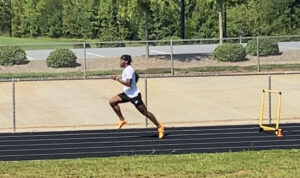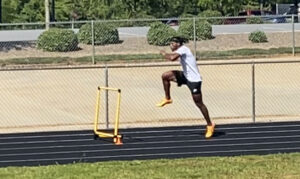Don’t Forget about Upper Body Posture
by Steve McGill
To sprint over hurdles efficiently, there are so many factors that athletes and coaches must consider, just in regards to technique alone, without even getting into rhythm, speed, strength, flexibility, etc. We coaches tend to place the bulk of our emphasis on lead leg mechanics and trail leg mechanics, followed by lead arm mechanics and trail arm mechanics. A key element that we don’t emphasize nearly enough, in my opinion, is upper body posture. I contend that upper body posture is as important as any other element of technique, and that it is an element that allows all four limbs to function effectively. In this article, I will give my perspective on what we want the upper body posture to look like, and why.
[am4show not_have=’g5;’]
[/am4show][am4guest]
[/am4guest][am4show have=’g5;’]
Before getting into the specifics of upper body posture while hurdling, let me first establish the type of upper body posture I’m looking for while sprinting. When I first start with a new athlete, one of the first things I’ll have them do is place both feet together while standing straight up, eyes looking forward, chin up, chest pushing forward. Then I’ll instruct them to roll forward on the balls of their feet. With this posture, the very act of rolling forward onto the balls of the feet creates an angle where the upper body is slightly tilted forward. That slightly forward angle is the angle we want with our upper body when sprinting.
By maintaining that angle between the hurdles, we don’t really have to “lean” when we attack the hurdle. We’re already pushing forward, so the presence of the hurdle forces us to push forward more deeply. It should happen naturally if our posture between the hurdles is slightly forward like it needs to be. But because hurdlers often think of sprinting and hurdling as separate actions, they often sprint with a posture that is too erect, and then when it’s time to attack the hurdle, they try to lean, but the lean can never be deep enough because the upper body is trying to lean from a too-upright position.
Running too erectly between the hurdles messes up everything you’re trying to do over the hurdle. Because it leads to a lean that is not deep enough, that means that the foot of the lead leg will kick out too soon, before the knee is higher than the bar. This swinging action of the lead leg causes the trail leg to lag, and to then flatten out instead of driving up high and tight. The arms, in an attempt to compensate for the balance issues, created by the swinging lead leg, will swing from side to side and hang in the air too long.
Even hurdlers who have a good start, and who attack the first hurdle aggressively without popping up too soon, often have the habit of standing up too tall as they land off the first hurdle, effectively ruining all the momentum they gathered from the starting blocks. Standing up too tall off the hurdle is like putting the brakes on while moving at full speed. Then you have to work real hard to speed back up again, and all that extra work will lead to a crappy latter part of the race, as fatigue becomes a factor way too early.
I teach my hurdlers to “push forward, push forward, push forward.” And, when in doubt, stay forward. Straight from the blocks, drive forward, not upward. As you gradually rise to full height, keep pushing the chest forward. Off the first hurdle, keep pushing the chest forward. Between the hurdles, keep pushing the chest forward. At no point should you consciously attempt to “stand up.” The upper body is going to gradually come up anyway, naturally, so let the natural process occur. But by staying tall on the balls of the feet, you ensure that your chest will stay pushing forward.
The key to the “lean,” or, the deepening of the forward positioning, is the timing of it. I’ll use the word “lean” here for the purposes of explanation. The lean has to occur at take-off. A lot of hurdlers lean too late, after they’ve taken off, and that only leads to a jerky action that interrupts the fluidity of the movement. So, like I’ve said in past articles, there are several things that happen at once during take-off: the trail leg is pushing off the ground, the knee of the lead leg is driving upward, the hand of the lead arm is driving upward, the hand of the trail arm is driving to the back pocket, the hips are pushing forward, and the upper body is leaning forward more deeply, with the eyes staying forward and the chin staying up. The angle of the lean is so important because, if the eyes look down and the chin points down, you’re not really leaning forward, and you’re not leaning from the waist. Instead, you’re leaning from the upper body, kind of just rolling your shoulders forward, which does nothing in regard to creating speed through hurdle clearance and off the hurdle. When the angle of the lean is forward, and when the timing of the lean is synchronized with the other movements mentioned above, then the athlete is basically catapulting him/herself forward, but doing so in a manner that is controlled and efficient so that airtime is minimized and speed off the hurdle is maximized.

This photo exhibits the type of posture I like between the hurdles. Eyes up, chin up, chest pushing forward as the knees drive forward.

This photo exhibits the type of posture I like at take-off into the hurdle. The knee of the lead leg is rising higher than the crossbar; the heel of the lead leg is tucked under the hamstring, ensuring that the knee leads the way; the trail leg is pushing off at a forward angle, not an upward angle; the hips are pushing forward; the lead arm is rising to nose level; and the chest is beginning to push down over the thigh of the lead leg, creating momentum through the hurdle.
So, while there are no drills specific to improving sprinting posture and hurdling posture, the upper body posture is something that coaches and athletes always want to be aware of when practicing technique, drilling, doing block starts over hurdles, or doing anything hurdle-related.
[/am4show]
